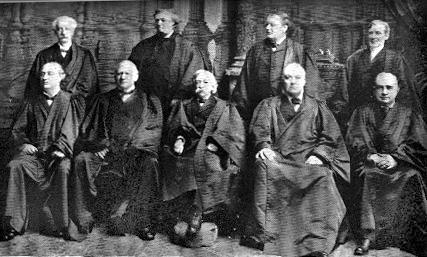 (This image of the 1896 Supreme Court is from awesomestories.com.)
(This image of the 1896 Supreme Court is from awesomestories.com.)The next president could appoint up to four Supreme Court justices. Depending on who gets elected, that could make the court either progressive or very regressive for many years into the future. The leading Republican candidate, Donald Trump, would like to see a very regressive Supreme Court. Here is how Ian Millhiser at Daily Kos describes the kind of court Trump would create:
Early in his campaign for the White House, Republican presidential frontrunner Donald Trump suggested that his nominees to the Supreme Court may be unexpectedly moderate — he said that his sister Judge Maryanne Trump Barry, a left-of-center Clinton appointee to the United States Court of Appeals for the Third Circuit, would make a “phenomenal” justice. Speaking at a South Carolina political forum on Saturday, however, Trump disavowed any notion that his justices would bring moderation to the Court. To the contrary, Trump suggested that he would like to fill the Court will justices who literally want to erase nearly a century of American law. At the forum, which was hosted by South Carolina Attorney General Alan Wilson (R), Trump named Justice Clarence Thomas as his favorite justice, labeling the Court’s most conservative member “very strong and consistent.” He also joined the chorus of Republicans angry that Chief Justice John Roberts twice turned aside lawsuits seeking to gut the Affordable Care Act. “Justice Roberts really let us down,” according to Trump. “What he did with Obamacare was disgraceful, and I think he did that because he wanted to be popular inside the Beltway.” Trump’s suggestion that Roberts is insufficiently conservative is itself an extraordinary statement, although it has increasingly become Republican orthodoxy. Roberts authored the Supreme Court’s decision neutering a key prong of the Voting Rights Act. He joined the Court’s decision relaxing campaign finance restrictions in Citizens United v. FEC, and even authored a decision legalizing certain forms of money laundering by campaign donors. He consistently votes to give corporate defendants new ways to avoid lawsuits brought by consumers and workers injured by that corporation. He voted to give religious objectors unprecedented new abilities to limit the rights of their employees. And his views on race largely reflect his impatience with the fact that many of America’s civil rights laws still exist. Indeed, virtually the only significant area of the law where Roberts has disappointed Republicans is the two major challenges to Obamacare. In the first suit, Roberts accepted an anti-Obamacare argument that, according to a conservative judge who received the Presidential Medal of Freedom from President George W. Bush, has no basis “in either the text of the Constitution or Supreme Court precedent” — although he did uphold the bulk of the law on an alternative ground. In the second case, Roberts rejected the unique legal argument that most of the text of the Affordable Care Act does not count. These are hardly the hallmarks of a judge going out of his way to side with liberals. Yet, while Trump’s statement that Roberts is insufficiently conservative should concern liberals, his apparent desire to appoint more justices like Thomas should petrify any American who depends on the web of workplace and anti-discrimination laws that were enacted in the later half of the twentieth century. The Constitution permits Congress to “regulate Commerce . . . among the several States,” and this power forms the basis for most federal law governing businesses and the workplace — including anti-discrimination law such as bans on employment discrimination and whites-only lunch counters. In the late nineteenth century, however, the Supreme Court held that activities that are necessary to commerce such as manufacturing, agriculture and mining are beyond Congress’s power to regulate. This distinction formed the basis for harsh decisions deregulating the workplace, such as the Court’s 1918 decision in Hammer v. Dagenhardt, which struck down federal child labor laws. Had the Court continued to enforce this distinction (Hammer was overruled in 1941) it also would have likely been impossible for Congress to forbid discrimination by most employers. Justice Thomas, however, believes that the Constitution must be read as it was originally understood in 1918. In a concurring opinion in the 1995 case United States v. Lopez, Thomas claimed that the word “commerce,” as it is used in the Constitution, “was used in contradistinction to productive activities such as manufacturing and agriculture.” This, of course, is the same reasoning that animated decisions such as Hammer. A majority of five Thomases on the Supreme Court, in other words, would be apocalyptic for anyone who believes that the nation’s workplaces should be regulated. Should Trump become president, moreover, it is entirely possible that he could achieve this goal. On the day that the next president takes office, three justices will be over the age of 80, while a fourth, Justice Stephen Breyer, will be 78. That’s four seats that a President Trump could conceivably fill with clones of Justice Thomas. When you add the original Justice Thomas to the mix, that’s enough votes to build a bridge to the nineteenth century.

